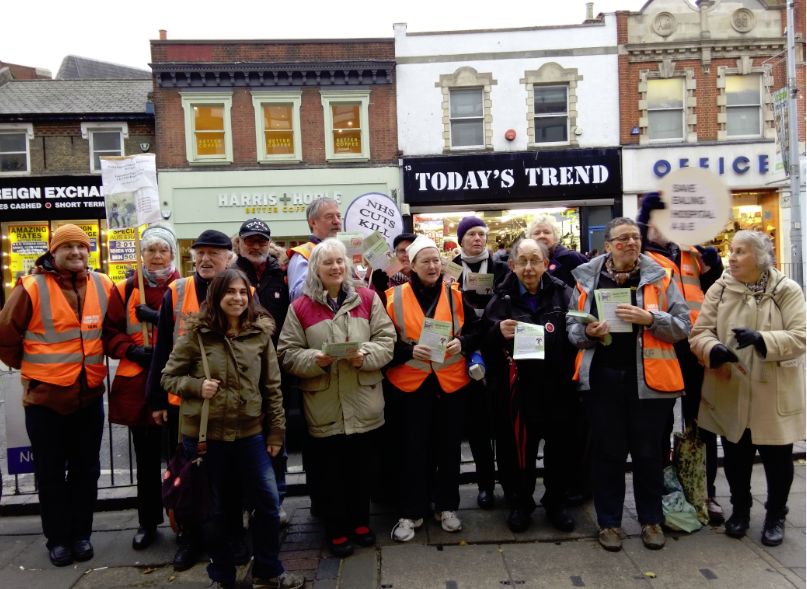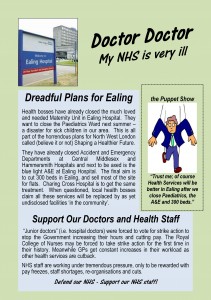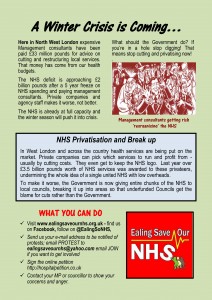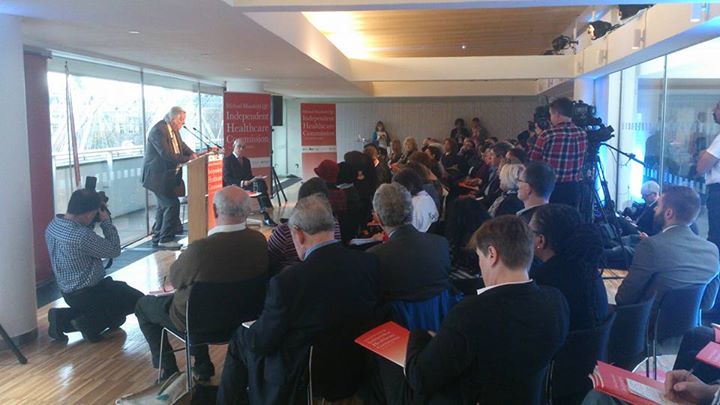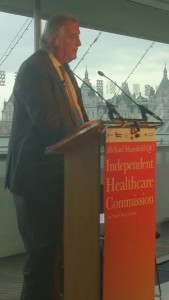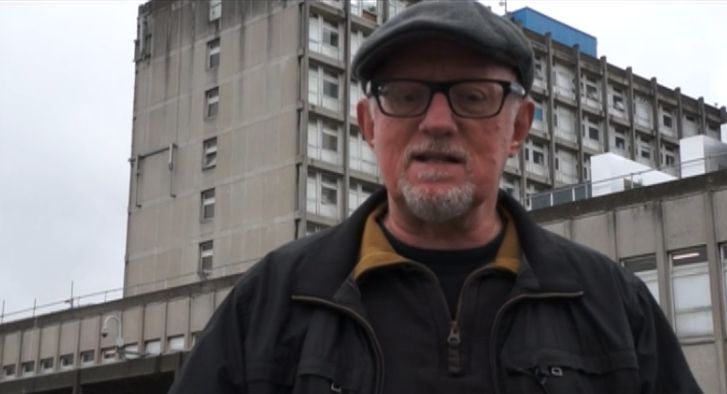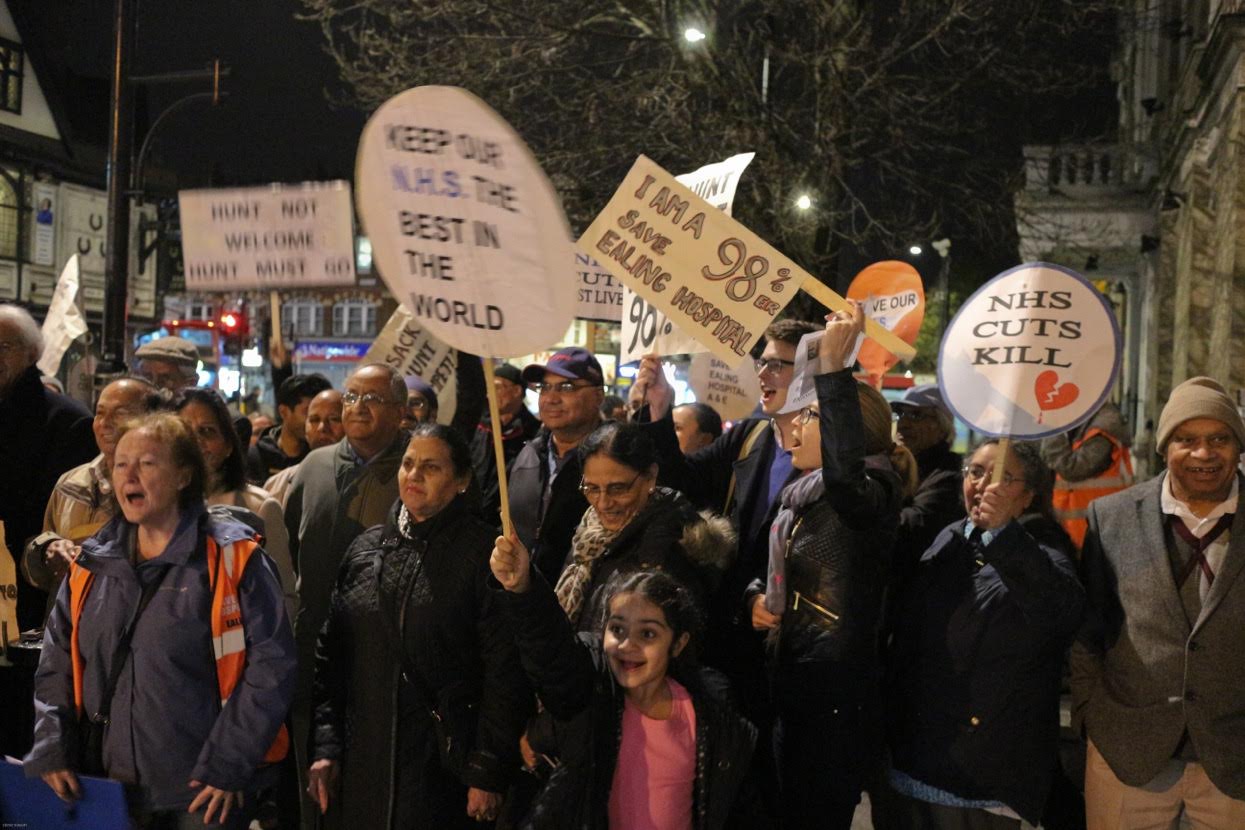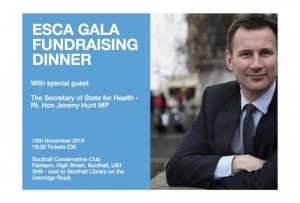Issue: 29
October 2015
This occasional newsletter is researched, written and edited by a group of concerned residents in Ealing, West London who want to preserve our NHS. We view the wholesale engagement of private, for-profit healthcare service suppliers as unnecessary, profligate and dangerous. Process improvement is what is needed in our NHS – not revolution.
80% of NHS Hospitals are Running at a Loss. If the NHS were a ‘Real’ Market These Hospitals would Close Down
The farcical notion that the NHS can be run on market lines is being crucially exposed by most NHS hospitals being deemed to be failing. The biggest ‘failure’ to date is the £135 million annual loss at Barts Hospital. These failures revolve around the impossibility of balancing the books while maintaining clinical services at the level expected.
With an effective annual uplift in the NHS budget of just 1% set against the 3/4 % annual increase in patient demand, no doubt all NHS hospitals will make losses next year. Add to this the proposed 30% reduction in pay for junior doctors, which will increase staff emigration, turnover, recruitment and agency staff costs, then the losses will exceed the current year’s.
When will the Government accept the reality that providing a state healthcare system is a cost centre not a chocolate teapot of a profit centre?
‘Of Course, Shaping a Healthier Future is Dead In The Water,’ Said Sir Richard Sykes
The Save Charing Cross and Hammersmith Hospitals Group have reported this remark made to them at the Imperial College Healthcare NHS Trust AGM on 9 September 2015. Sir Richard is the Trust’s Chair.
If this is true one must ask the question what is the new NHS NW London strategy? Will Charing Cross and Ealing Hospitals remain as Major Hospitals? Will the two A&E units survive? Will the ailing Out Of Hospital strategy be ditched? Will the architects of SaHF fall on their swords?
NHS Ealing Hospital Urgent Care Centre: Trial by TV and then by Ealing Council
Ealing Council’s Health and Adult Social Services Standing Scrutiny Panel met on 9 September 2015. The feature of the meeting was the scrutiny of Ealing Hospital’s Urgent Care Centre (UCC). This scrutiny was triggered by the damning UCC revelations by patients and staff in the ITV ‘Despatches’ programme which was screened on 22 July 2015. Ealing Council summoned the UCC operator Care UK, the NHS entity managing the Care UK contract Ealing Clinical Commissioning Group (ECCG), ITV and the independent programme maker to attend. Care UK senior management and ECCG senior management attended. The ITV folks and the programme maker failed to turn up. The grilling took 70 minutes.
Highlights for me were:
+ An annoying thread (which ran through the whole session) was talk of ‘allegations’ made in the TV programme. These were not allegations, they were video footage of evidence.
+ The Care UK MD said that Care UK had never made a profit in all the four years of the UCC contract. My business background tells me that suppliers making a loss is an unhealthy and unsustainable state of affairs. Also, if her statement is in actual fact true, then unless there was more money on the table why would Care UK bid to continue the UCC contract from 2016 to 2021? And if this were the case, why should they burst a gut for the remaining 10 months of the contract?
+ Care UK pretty much suggested that the journalist had somehow tricked Care UK staff to say and do inappropriate things. This smacks of a classic symptom of denial.
+ ECCG and Care UK gave the impression that they really did not think there were problems with the service. One of the Councillors suggested there was a systemic ‘cultural’ problem amongst UCC staff. What he wanted to see was evidence of Care UK attempting to change this culture. Care UK had no response to this well made point.
+ Care UK’s MD was asked what were patients to do if they were not happy with the service at Ealing Hospital UCC. Her response ‘go to Brent UCC’ brought gasps of shock from members of the public in the audience. It really was a crass response.
+ ECCG has commissioned an independent review of aspects of the UCC service and ECCG’s relationship with UCC/Care UK. As ECCG is responsible for monitoring Care UK, and in fact paying it, it seems inappropriate for ECCG to be specifying the terms of this review or even commissioning it. It’s a bit like marking your own homework. A formal review should have been commissioned by someone other than the NHS – Ealing Council or Healthwatch Ealing possibly. Let’s not also forget that money paid to consultants to carry out a review could have been spent on providing healthcare services. ECCG also failed to confirm it would place the review into the public domain.
+ There are only 10 months left of the five year Care UK UCC contract. Ealing PCT chose Care UK to set up and run the UCC in 2011. ECCG subsequently inherited the contract. What will matter soon is who will run the UCC as from August 2016 to July 2021. This is a period during which, as far as we know, Ealing Hospital A&E will close (as per the NHS NW London Shaping a Healthier Future strategy), much of Ealing Hospital will be demolished and a new ‘Local Hospital’ will be built on the site. However, amazingly, ECCG at the meeting stated that Ealing Hospital A&E will not close down. But this is all semantic gobbledegook, as some time in the medium term flashing blue light ambulances will not arrive at Ealing Hospital and there will be no acute/ICU consultants and no acute/ICU beds. And in the well established vocabulary of the NHS this amounts to no A&E.
Ealing Council Scrutiny also Highlights Areas of Concern for Children’s Health in Ealing
Areas of concern were MMR vaccination rates, low birth weights for babies, 4-5 year old obesity, under 5 year olds’ tooth decay, 0 –4 year olds’ A&E attendance and poverty amongst dependent under 20 year olds.
Ex-Ealing Hospital Midwives Overworked and Unhappy After Relocation to Paddington and Isleworth.
Anecdotal evidence is reaching us about former Ealing Hospital midwives being overworked and unhappy working at St Mary’s and West Middlesex Hospitals. The break-up of the happy and successful Maternity Unit at Ealing Hospital will forever be a stain on the ailing NHS NW London ‘Shaping a Healthier Future’ (SaHF) strategy.
Independent Healthcare Commission (IHC) to Launch its Final SaHF Report on 21 November 2015
The IHC – also known as the Mansfield Commission – will reveal its final report at an event at Hammersmith Town Hall on Saturday 21 November 2015. The commission was set up by Brent, Ealing, Hammersmith & Fulham and Hounslow Councils in 2014. It has spent months collecting evidence on the implementation and performance of the 2012 NHS NW London ‘Shaping a Healthier Future’ (SaHF) strategy. The completion of the final report has been delayed by the NHS submitting additional information after the submission deadline.
John Lister, one of the IHC commissioners, addressed Ealing Save Our NHS on 22 September 2015. Some of the points he highlighted included:
+ SaHF cost estimates have risen from £120 million in 2012 to £1.3 billion in 2015
+ Some 28 final SaHF Business Cases have been consistently promised and not delivered
+ SaHF has effectively stalled because the Treasury has not signed off the £1.3 billion capital costs. The closure of Central Middlesex A&E, Hammersmith Hospital A&E and Ealing Hospital Maternity Unit is all SaHF can do without cash for new build.
Neighbourly Care Southall (NCS) Wins Ealing Council Grant of £1+ Million to Provide Care Services for the Elderly Across Ealing. Appeal By Age UK Ealing is Rejected
Apparently the reason why NCS won the grant award and won the appeal is because its proposal was adjudged to better meet Ealing Council’s needs. It seems Ealing Council wants a single organisation to provide elderly care services in all seven Districts of Ealing embracing all major religious and ethnic groups.
NCS, now re-branded as Neighbourly Care, has 3,500 members in Southall alone, with 76 different countries of birth. It suspects that it is the most multi-cultural group operating in the UK. It plans to set up 16 community hubs for the elderly throughout Ealing and is specially targeting Districts which have historically had little support, including Greenford, Northolt, Perivale and parts of Acton.
Age UK Ealing has received significant annual grant funding from Ealing Council for years. However as from April 2016 it will receive no council funding for providing services to the elderly over the following three years. Ealing Council announced this in July 2015. Age UK appealed and lost its appeal in September 2015. It is only because of prudent financial management over the years that Age UK Ealing will be able to continue operating its range of services – giving it time to search for alternative sources of funding.
One of the big losers through withdrawal of Ealing Council grant support is Southall Day Centre, which has lost 75% of its funding. The centre, founded in 1978, is affiliated to the housing organisation Catalyst which loans the centre premises. The centre is run by seven organisations including Age UK Ealing, MIND, Mencap, the Anglo Caribbean Society and the Centre for Armenian Information and Advice. The centre was the first one in the UK to tailor its services for older people from the Asian community. It has over 2,000 members. However it’s alleged that the centre exclusively supports the Punjabi community. If true then this may have counted against it. The loss of grant will mean the closure of its only two sites in Shackleton Road and Western Road. So a valuable community service operating successfully for 37 years will disappear.
CQC Rates West London Mental Health Trust (WLMHT) as ‘Requires Improvement’
Following a five day inspection in June 2015, The Care Quality Commission (CQC) has reported that the WLMHT requires improvement in relation to its being safe, effective and well led. It also found fault in the Trust’s failure to keep proper records. CQC also rated the Trust’s running of the Broadmoor high security hospital as inadequate. It found inadequate staffing levels at the hospital. CQC had concerns about patients being physically restrained too often and spending too much time in their rooms.
WLMHT was though credited by CQC for being caring and responsive. CQC found many areas of WLMHT where care was delivered by hard-working, caring and compassionate staff.
NHS care.data Boss Kelsey Jumps Ship
Tim Kelsey, NHS England’s National Information Director, has announced he is leaving his job and this country for Australia. Kelsey is responsible for the care.data shambles. care.data was supposed to help the NHS to share medical records. Kelsey launched the project in 2013 and it has consistently been beset with problems. The biggest problems have been the sale of medical records to private companies, data insecurity and an unsuitable patient opt-out system. In February 2014 it was revealed that 47 million NHS patients’ records were sold to insurers by the Institute and Faculty of Actuaries. In September 2015 the care.data pilot trials were halted by the Government.
Kelsey initially worked as a journalist and co-founded Dr Foster Intelligence in 2000. Dr Foster collects and publishes performance data on healthcare services. In 2006 the Department of Health acquired a 50% stake in Dr Foster for £12 million. Some said the price was 50% too high. After a spell with the NHS gravy train called McKinsey & Co, he joined the Cabinet Office and then the NHS in May 2012. In Australia Kelsey will be re-united with Dr Foster as he joins Telstra Health who acquired Dr Foster in March 2015.
Informed sources claim that Kelsey is leaving at a time when serious questions regarding consent and transparency concerning NHS England’s flagship data programme remain unanswered.
Cancer Diagnosis Within Four Weeks: But What About Mental Health Diagnosis Targets?
This is an admirable new target for cancer patients. A similar target needs to be set for mentally ill patients. There are an estimated 2.3 million cancer sufferers in the UK. But there are probably three times that number of mentally ill people. It’s true that cancer can lead to an early death and terrible suffering. However mental ill health can mean a lifetime of suffering.
One probably cannot make direct comparisons between diagnosis for cancer and diagnosis for mental illness. There are currently no ‘tests’ for mental health problems and mental health diagnosis is not a straightforward process. For mental health the four week target should be an assessment by a psychiatrist.
An encouraging sign for mental health from the new labour Party opposition team is the creation of the new post of Shadow Minister for Mental Health. This reflects Jeremy Corbyn’s support for increased expenditure on mental health services. Luciana Berger MP has been appointed to this position.
Where Does the Provision of New Health Care Services Fit Into the Planning System?
What planning system you might ask. Statutory Local Plans and Neighbourhood Plans are typically spatial plans which stretch over 15 years. Our regional plan – the London Plan – has a planning window of 26 years. However NHS England seems to have a five year plan. NHS NW London’s ‘Shaping a Healthier Future’ (SaHF) plan was initially conceived with a three year plus time frame, beginning in 2013.
A big part of the SaHF plan involves demolishing some major hospitals and replacing in-hospital healthcare services with ‘Out-Of-Hospital’ (OOH) healthcare. OOH services need premises in which patients can be treated. These premises could be our own homes, existing or new GP surgeries or new community healthcare centres.
Ealing’s 2012 Local Plan targets building 12,400 new homes by 2026. To service the healthcare needs of the 30,000 new patients who will occupy these new homes will need 14 additional GPs in Ealing. We’ll need expanded and new GP surgeries, new community healthcare centres and more GP practice nurses. To supply premises there will have to be some change of use obtained for existing buildings and land for new build. So where is the 15 year spatial plan for NHS services in Ealing? I can’t find one and I suspect it does not exist.
However according to the London-wide Local Medical Committee (representing GPs in 27 London boroughs), the GP service in London has reached saturation point. Add to this that 140 London GP surgeries are at risk of closure over the next few years. Also the number of GP practice nurses in London is declining. In February 2015 London’s population was sized at 8.6 million. ONS predicts that by 2030 the population will reach 10 million. This translates to over one million additional NHS patients.
So ..to use an aviation analogy we are not only flying blind we are also running out of fuel…
 and their parents as it’s not walk-in and attendance is only by GP referral. We all know that access to GPs is not rapid. Another limiting factor is that the RAC is only open for four hours each weekday.
and their parents as it’s not walk-in and attendance is only by GP referral. We all know that access to GPs is not rapid. Another limiting factor is that the RAC is only open for four hours each weekday.


